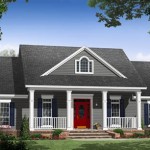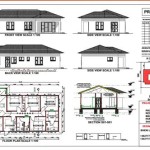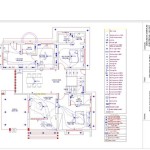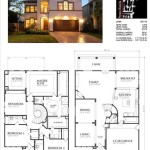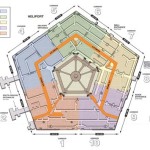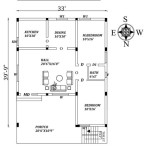```html
6 Purchase House Plans to Consider Before Building
Purchasing house plans is a crucial step in the home building process. Carefully considering various plans ensures that the final structure aligns with individual needs, budget constraints, and aesthetic preferences. This article examines six fundamental purchase house plans that prospective homeowners should consider before embarking on construction.
1. Stock House Plans: The Economical and Accessible Option
Stock house plans, also known as pre-drawn or catalog plans, represent a readily available and cost-effective option for potential homeowners. These plans are developed by architectural firms and are available for purchase without modification. Stock plans are advantageous due to their lower cost compared to custom designs. The efficiency in cost stems from the avoidance of original design fees and the leveraging of previously established blueprints.
The selection of stock house plans is extensive, covering a wide range of architectural styles, square footage, and layout configurations. This abundance allows buyers to find a plan that aligns with their general requirements. However, the standardized nature of stock plans presents certain limitations. They are not specifically tailored to a particular building site, requiring adaptation to the property's unique topography, orientation, or local building codes.
Furthermore, modifications to stock plans, while often possible, incur additional expenses. Extensive alterations may diminish the cost savings initially associated with the plan. Therefore, a thorough assessment of the plan's suitability to the building site and desired design modifications is essential before purchase. Consider factors such as foundation type, climate considerations, and local regulatory requirements.
Stock house plans are suitable for individuals seeking a straightforward and economical approach to home building, wherein the building site presents few unusual challenges, and minimal modifications are needed. Careful evaluation of the plan's compatibility with the building site and anticipated alterations is critical to realizing the financial benefits.
2. Custom House Plans: Tailored to Individual Needs and Site Specificity
Custom house plans represent the most personalized approach to home design. This involves engaging an architect or residential designer to create a unique plan tailored to specific individual needs, lifestyle preferences, and the characteristics of the building site. Custom plans allow for complete control over every aspect of the design, from the overall aesthetic to the minute details of interior layout and functionality.
The primary advantage of custom plans lies in their site-specificity. Architects can design the house to maximize views, optimize natural light, and take advantage of the land's topography. Custom plans also address unique site challenges, such as sloping lots, unusual soil conditions, or restrictive zoning regulations. This level of adaptation can result in a more efficient and aesthetically pleasing home.
However, custom house plans are the most expensive option. Architectural fees typically range from a percentage of the total construction cost (often 8-15%) or an hourly rate. The design process is also considerably longer, involving multiple meetings with the architect, preliminary design sketches, and detailed construction documents. This extended timeframe requires patience and a commitment to collaboration.
Custom plans are best suited for individuals with unique design requirements, challenging building sites, or a strong desire for a home that reflects their individual style. The added cost and time investment are justified by the level of personalization and the potential for a superior outcome in terms of functionality, aesthetics, and site integration.
3. Modified Stock House Plans: A Balance of Cost and Customization
Modified stock house plans represent a hybrid approach, combining the cost-effectiveness of stock plans with the flexibility of customization. This involves purchasing a pre-drawn plan and then making alterations to adapt it to specific needs and site conditions. Modifications can range from minor changes, such as adjusting window sizes or moving interior walls, to more substantial revisions, such as adding square footage or changing the roofline.
Modified stock plans offer a compromise between the affordability of stock plans and the personalization of custom plans. They allow homeowners to make targeted changes without incurring the full expense of a completely custom design. However, the extent of modifications should be carefully considered. Extensive alterations can significantly increase the cost and complexity of the project, potentially negating the initial cost savings.
Engaging an architect or residential designer is recommended for projects involving significant modifications. These professionals can assess the structural implications of changes, ensure compliance with building codes, and provide design expertise to maintain the overall integrity of the original plan. It is advantageous to obtain a detailed estimate for the cost of modifications before committing to the purchase of the stock plan.
This option is appropriate for those who find a stock plan that is close to their requirements but needs specific alterations to better suit their site or lifestyle. It offers a balance between cost, customization, and control over the design process.
4. Online House Plan Resources: Accessible and Varied Options
The internet provides access to a vast array of online house plan resources. Numerous websites offer a wide selection of stock plans, modified stock plans, and even custom design services. These online platforms provide a convenient and accessible way to browse different styles, compare prices, and download plan sets.
However, caution should be exercised when purchasing house plans online. The quality of plans can vary significantly, and it is essential to verify the credentials and reputation of the vendor. Look for plans that are stamped by a licensed architect or engineer, indicating that they meet professional standards. Review sample plan sets and read customer reviews before making a purchase.
Furthermore, ensure that the online vendor offers adequate customer support and can provide assistance with plan modifications or technical questions. Understand the terms of sale, including refund policies and copyright restrictions. It is prudent to consult with a local building professional to review the plans before submitting them for building permits.
Online resources offer a convenient starting point for exploring house plan options, but thorough due diligence is critical to ensure the quality and suitability of the chosen plan.
5. Specialty House Plans: Targeting Specific Lifestyles and Needs
Specialty house plans cater to specific lifestyles, building requirements, or design preferences. Examples include accessible designs for individuals with disabilities, energy-efficient designs focused on sustainability, and small house plans for minimalist living. These specialized plans address unique needs that may not be adequately met by standard stock or custom designs.
Accessible house plans, for instance, incorporate features such as wider doorways, ramps, and accessible bathrooms to accommodate individuals with mobility challenges. Energy-efficient house plans prioritize insulation, passive solar design, and renewable energy technologies to minimize energy consumption. Small house plans maximize functionality within a limited square footage, offering an affordable and environmentally conscious building option.
When considering specialty house plans, it is essential to carefully evaluate the specific features and benefits offered by each plan. Ensure that the plan meets all relevant building codes and accessibility standards. Consult with experts in the relevant field, such as accessibility specialists or energy consultants, to ensure that the plan effectively addresses the intended needs.
For individuals seeking a home that caters to unique lifestyle requirements or environmental concerns, specialty house plans provide a valuable alternative to conventional designs.
6. Green and Sustainable House Plans: Prioritizing Environmental Responsibility
Green and sustainable house plans prioritize environmental responsibility and resource conservation. These plans incorporate features such as passive solar design, high-performance insulation, rainwater harvesting systems, and the use of sustainable building materials. The goal is to minimize the environmental impact of the home and reduce its long-term operating costs.
Sustainable house plans often incorporate strategies to minimize energy consumption, reducing reliance on fossil fuels. This includes optimizing building orientation to maximize solar gain in winter and minimize heat gain in summer, using energy-efficient windows and doors, and incorporating renewable energy sources such as solar panels. Water conservation measures, such as low-flow fixtures and rainwater harvesting, can further reduce environmental impact.
The selection of building materials is a critical aspect of sustainable house design. Using recycled materials, locally sourced materials, and materials with low volatile organic compound (VOC) emissions can minimize the environmental footprint of the home. Sustainable plans often incorporate natural landscaping techniques, such as xeriscaping, to reduce water consumption and promote biodiversity.
Homeowners interested in building an environmentally responsible home should consider green and sustainable house plans. These plans offer a roadmap for creating a comfortable, energy-efficient, and environmentally conscious living space.
```
Large House Plans Basement Garage Floor

Floor Plan Two Story House Plans 6 Bedroom Layout

House Plans The Best Floor Home Designs Abhp

Lochshire House Floor Plan Frank Betz Associates

House Plans The Best Floor Home Designs Abhp

House Plans Home Floor Architecturalhouseplans Com

Home Plans Lk Sri Lanka

Cumberland Crossing House Floor Plan Frank Betz Associates

House Plan Maywood Sater Design Collection

House Plans The Best Floor Home Designs Abhp

